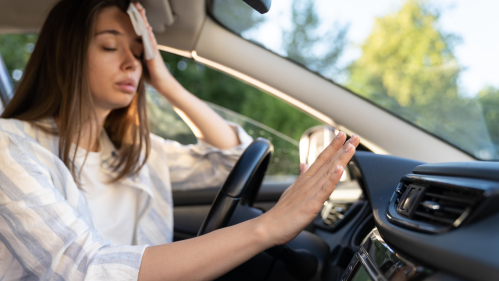Hot Cars, Hidden Dangers: What Every Driver Needs to Know This Summer

An expert at Rutgers New Jersey Medical School shares life-saving tips to keep cars cool and passengers safe during summer heat
As temperatures rise each summer, so do the risks to our health – especially inside our vehicles.
The interior of a parked car can reach dangerous levels quickly, becoming a trap of superheated air that endangers people and pets.

“As a physician, I’ve seen the effects of heat exposure firsthand: heat stroke, dehydration, dizziness and respiratory distress,” said Khalil Savary, an associate professor in the Department of Pediatrics at Rutgers New Jersey Medical School. “But the good news is, with a few simple steps, you can reduce the heat in your vehicle and protect your health and even the health of our planet. You don’t need to idle your car or blast the AC to stay cool.”
Savary, a pediatric pulmonologist, said with smarter, greener strategies, motorists can:
- Lower interior temperatures by 20 to 50 degrees Fahrenheit
- Protect one’s health and reduce heatstroke risks
- Save fuel and reduce emissions
Maintenance: Start With Your Car’s Health
Just like the human body, your car needs regular maintenance to perform well under pressure, especially in heat.
- Check your air conditioning system: Ensure the car’s AC is fully functional and serviced yearly. “A well-functioning AC can prevent overheating – not just for the engine, but for you,” Savary said.
- Inspect coolant levels: The engine’s cooling system needs proper coolant to avoid breakdowns in summer traffic.
- Battery health: High heat can drain the battery faster. Replace aging batteries and check for corrosion.
- Window seals and insulation: Make sure the car’s seals aren’t letting in excess heat or humidity.
Prevention: Stop Heat Before It Starts
Keeping your car cool starts before you even start the engine.
- Drive during cooler parts of the day: Shift errands to early morning or late evening to avoid peak heat exposure.
- Park in the shade: Look for trees, garages or north-facing walls. Shaded parking can keep a car up to 20 degrees cooler. Point the car’s rear toward the sun so less direct light hits the windshield.
- Use sunshades, windshield umbrellas or reflective visors: These block direct sunlight, dramatically reduce dashboard, side window, trunk and seat temperatures, and help keep temperatures lower throughout the cabin. A sunshade can be made using cardboard or foil boards under the windshield.
- Crack the windows: When parked, opening windows a half-inch allows heat to escape without compromising security.
- Use solar-powered fans: These small, dashboard-mounted fans help ventilate hot air out of the car when it’s parked.
- Cover interior surfaces: Drape light-colored towels over seats, dashboards and steering wheels to absorb less heat.
- Open all doors for 30 seconds or roll down opposite windows: Open front-left and rear-right windows (or vice versa) to create airflow channels and create cross-ventilation to rapidly expel hot air before entering. Alternatively open the trunk briefly before entry to release hot air in sports utility vehicles and hatchbacks.
- Tint windows (where legal): Tinting can reduce ultraviolet exposure and cabin heat while protecting interior materials.
Protection: Safeguard People and Pets
Extreme car heat isn’t just uncomfortable. It’s dangerous, Savary said.
- Never leave children, elderly adults or pets in a parked car: Avoid doing this, even for a few minutes. Temperatures can rise by 20 degrees in 10 minutes even with the windows cracked.
- Touch-test before entry: Always check car seats, buckles and steering wheels before letting children or pets inside. Before parking, flip seat buckles upside down to avoid burns.
- Hydrate: Keep a reusable water bottle in your car and refill it regularly. Heat and dehydration go hand in hand.
- Bring a spray bottle of water: A mist on your skin plus a fan equals instant evaporative cooling.
- Drive with the windows down briefly before turning on the AC: Letting the trapped heat escape before sealing the car allows the AC to work faster and more efficiently.
- Choose breathable seat covers: Fabric or ventilated covers reduce how much heat is absorbed compared with leather or vinyl.
- Install vent shades (rain guards): These allow motorists to crack windows while keeping out rain, improving ventilation when parked.
- Store an emergency kit: Include water, electrolyte tablets and a handheld fan or mist sprayer in your summer car kit.
The final takeaway is to park smart, protect vehicle surfaces and never leave loved ones behind, Savary said.
“Each of these steps is small, but together they create a powerful defense against summer heat,” he said. “And here’s the deeper truth: the intense heat we’re experiencing isn’t random. It’s part of a global pattern of warming that’s already affecting our health, our safety and our daily routines. The same heat that makes our cars unbearable is fueling wildfires, degrading air quality and straining our health systems. By making smart choices like reducing unnecessary idling, carpooling when possible and investing in energy-efficient vehicles, we can protect ourselves and also contribute to a healthier planet.”


